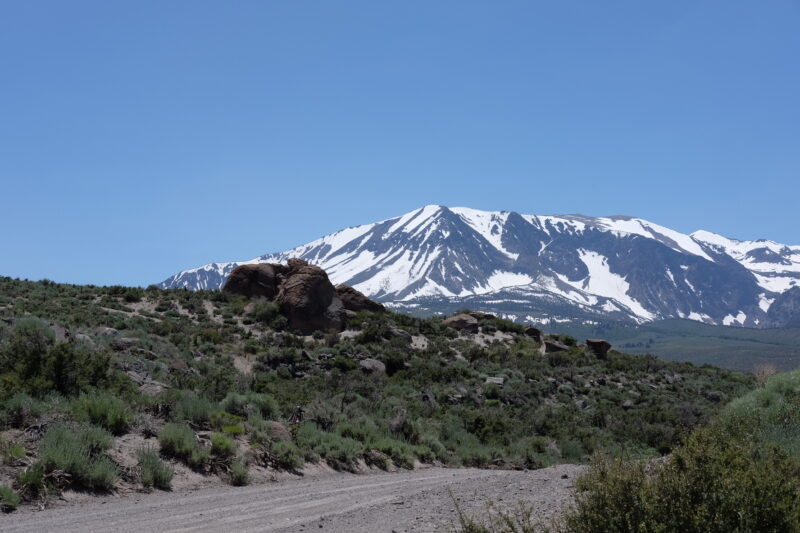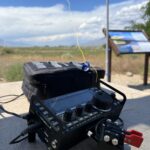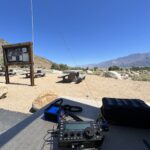
This week I was tasked with travel to Southern California for a field walk. The project is just getting started and doing a site visit is a critical part of forensic engineering.

Be that as it may, Manzanar is also a designated Parks on the Air park. I wanted to activate it. And time spent outside the rig for a few minutes is always good on a long trip. Sera got out of the rig for a run around while I got out the station. It was hot enough and there was enough traffic that I put her back in the rig.
I setup my folding table and chair under the rear hatch. Sera found a spot in the back out of the sun. It did not take long to put out an antenna and get the station on the air. In less than an hour I made my activation running 15 watts. I put everything away, gave Sera a drink, got one myself, and we got back on the road.
We spent the night at a Best Western in Sherman Oaks. It was noisy with city energy and the neighbors had a small dog that barked. This irritated Sera… she growled and grumbled several times that night. I rested some, enough to be up early to deal with accumulated email and the market.
There is a Denny’s in the facility, so I got some coffee and breakfast. Of course, I took The Girl some of my bacon and sausage, plus a couple of scrambled eggs for her breakfast.
It took about 45 minutes to get to the site and a couple of hours to see what I needed to see. I visited with my clients a bit, then headed back home.
Wisely, I had a reservation for a hotel in Lone Pine, California. This is about halfway between the site and home. I knew I would not want to drive all the way home after spending the morning on the site. So I did the easy thing and stayed over.

I had my quota after about 45 minutes. The 20-meter band was the go to band for this activation. I worked an Indonesian station and that surprised me. But DX is always welcome.
I put away the station and was able to make a meeting (virtual) using my iPhone at 1100h local. That did not last long, so Sera and I puttered a bit before heading north towards home.
At the north end of Independence, California (I think) is a BBQ place called the Copper Top. It was lunch time as we passed, so I turned back and bought a tri-tip sandwich. With pickles, onion (red onion), and a few jalapeños (and some sauce) it was good. But it was not as good as smoked Texas brisket. I shared a bite of sandwich with Sera, of course.
Then it was time to slug out the home stretch. I was tired, of course. I stopped a few times to stretch, give Sera some water, and get her out of the rig. Still, it was a tough slog.
I learned a few things, of course.
- I need to either add another set of blue Voile straps, or add a longer set of Voile straps to the antenna kit. The blue straps were not long enough to go around the 4×4 or 6×6 posts at the Alabama Hills site. I had to double the blue straps and then find a rock to keep the mast in place.
- I really think it would be better to log on the computer than my iPhone, particularly for POTA activations. The larger screen of the computer is simply easier to see.
- In addition, I was checking the Reverse Beacon Network for my spots. RBN is a great way for CW and digital operators to determine whether their signal is getting out to the spotter stations. The spotter stations decode the signals they hear and post the calling stations callsign, mode, signal strength, and speed to the webpage. If I am spotted, then I know the station is working because other stations are receiving my transmissions. It would be a lot easier to have multiple browser tabs open on the computer than it is to flip back and forth between tabs on my iPhone.
- I prefer a more leisurely activation, one where I have (and take) time to operate multiple modes and work through all the open bands to take the calls of the park hunters.
- But, when traveling, it is also a good break to stop for an hour, make at least ten contacts, be out of the rig for awhile, and get Sera out too. This type of activation has a place as well as the more deliberate, longer activation.
In all, the radio play was a nice break from the drive. I gave a few hunters an opportunity to chase a couple more parks. And Sera got a chance to be out of the rig for a while too. It was good. Life is good.